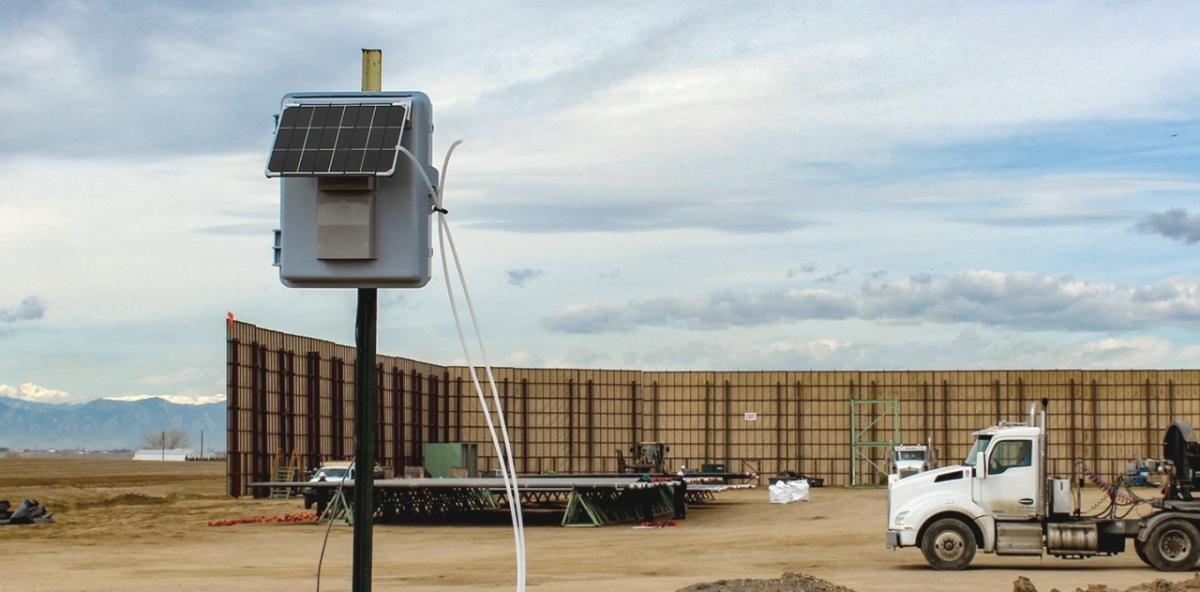WSP USA Develops Air Monitoring Equipment for Oil and Gas Facilities
AirWatch System™ solar-powered air monitoring equipment and data technology is providing continuous air emissions monitoring of hazardous pollutants.

A small, unassuming enclosure is emerging as an essential environmental tool with innovative technology that improves the way oil and gas facilities keep their worksites safe and environmentally compliant.
The AirWatch System™ hydrocarbon monitor provides continuous emissions monitoring at oil and gas facilities for hazardous air pollutants, including volatile organic compounds and hydrocarbons (C5-C16). The system was first implemented at a Colorado facility in 2019.
“New regulations in Colorado are requiring real-time air monitoring around oil and gas facilities,” said Steve Kahn, WSP environmental engineer. “There were limited equipment options for durable, reliable, real-time volatile organic compound monitors that could meet the requirements of various new regulations. The AirWatch System was developed to meet this new demand.”
LT Environmental, Inc., a WSP USA company, developed the proprietary AirWatch System, a monitor that measures ambient air quality at facility fence lines and is only available to WSP clients. Jeremy Espinoza, Kayla White and Brian Sulzberger were the key designers of the technology.
“The AirWatch System was developed and designed entirely in-house,” Kahn said. “Research and development with our clients, as well as conversations with regulators and municipalities, have allowed us to refine the system and how we operate it to maximize run time and account for factors such as weather extremes, real-time sampling, data validation, battery life and accuracy.”
The AirWatch System can identify leaks faster than traditional monitoring methods, which helps expedite process equipment repairs and remediation, reduce air emissions, and protect public health and the environment.
Real-time data is stored and accessed through a secure web-based portal. The AirWatch System collects air samples for laboratory analysis and speciation at a predetermined volatile organic compound threshold using mechanical automation. Meteorological data including temperature, humidity, wind speed and wind direction are also collected.
The units have parts-per-billion-level sensitivity that trigger automated alerts, which are then sent to WSP and the client when a predetermined volatile organic compound threshold is met, indicating further site investigation may be warranted.
Timely, Reliable Data
Prior to the AirWatch System, ambient air monitoring/fence-line monitoring was conducted primarily with dataloggers or laboratory analytical studies.
“Prior methods had a large delay between the time the data was collected and the time these data could be analyzed,” White said. “The AirWatch System allows for real-time data access and automated alerts that can be paramount in providing timely recommendations for additional site investigation or repair actions.”
Using complimentary technologies such as a thermal imaging camera (FLIR or equivalent) used for leak detection and repair (LDAR) programs, leaks identified by the AirWatch System can be pinpointed and resolved quickly, reducing environmental impacts and lost profit.
Additionally, the AirWatch System provides opportunity to collect an automated air sampling event remotely, at predetermined volatile organic compound threshold concentration to ensure samples are collected during a release event, allowing for quantification and speciation to protect public health and the environment.
This technology can be implemented in any area where volatile organic compound emissions are of concern and can be used for indoor or outdoor air quality monitoring. The system can be adapted to monitor for other air quality parameters as needed.
“We have seen elevated volatile organic compound levels at a location,” Kahn said. “Using the AirWatch System we were able to identify and fix the leaks in a timely manner, or trace the emissions to another off-site source.”
“Understanding the activities conducted around any particular monitor is critical for proper data interpretation and risk management,” Espinoza added.
Adapt and Overcome
The AirWatch System is continually adapting to meet the requirements of regulators and local municipalities. Recent changes include the development a robust quality assurance/quality control program to ensure proper sensor function, and adaptations to the system to increase reliability in harsh winter conditions and remote locations.
“Conducting real time continuous emissions monitoring systems (CEMS) has presented challenges in calibration gas selection, monitor component changes and operational changes,” Espinoza said. “As with any new program, challenges were anticipated and encountered, testing our ability to adapt and and ultimately has facilitated the success of the AirWatch System program, allowing us to learn from these challenges.”
The AirWatch System is the centerpiece of a mutually beneficial program that can promote good communication and increased trust between all stakeholders.
“Communities can have peace of mind knowing that nearby facilities are being closely monitored for fugitive emissions,” Sulzberger said. “And regulators have access to data that can aid in informed decision making during ongoing rule-making processes aimed at the industry.”
So far, the AirWatch System has been met with praise from the many WSP clients who have implemented the new technology.
“Clients have been extremely happy to have a reliable and cost-effective solution to the new air monitoring regulations, all backed by the support of an experienced team of environmental professionals,” Sulzberger said. “The AirWatch System has provided us with a challenging and rewarding opportunity to work with operators, regulators and communities during a time of regulatory reform and rulemaking, ensuring that all stakeholders can benefit.”
[To subscribe to Insights, contact the editorial staff at mailto:insights@wsp.com.]

